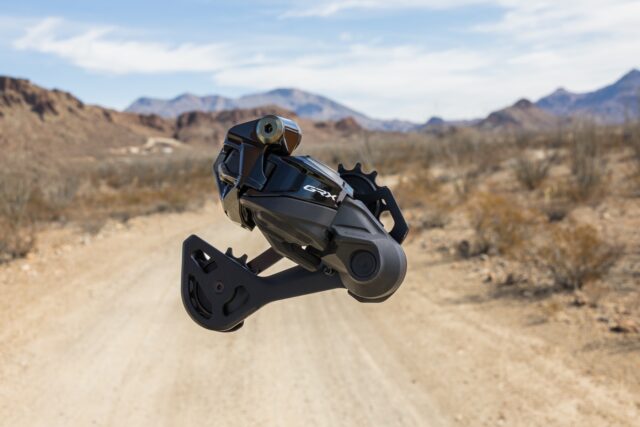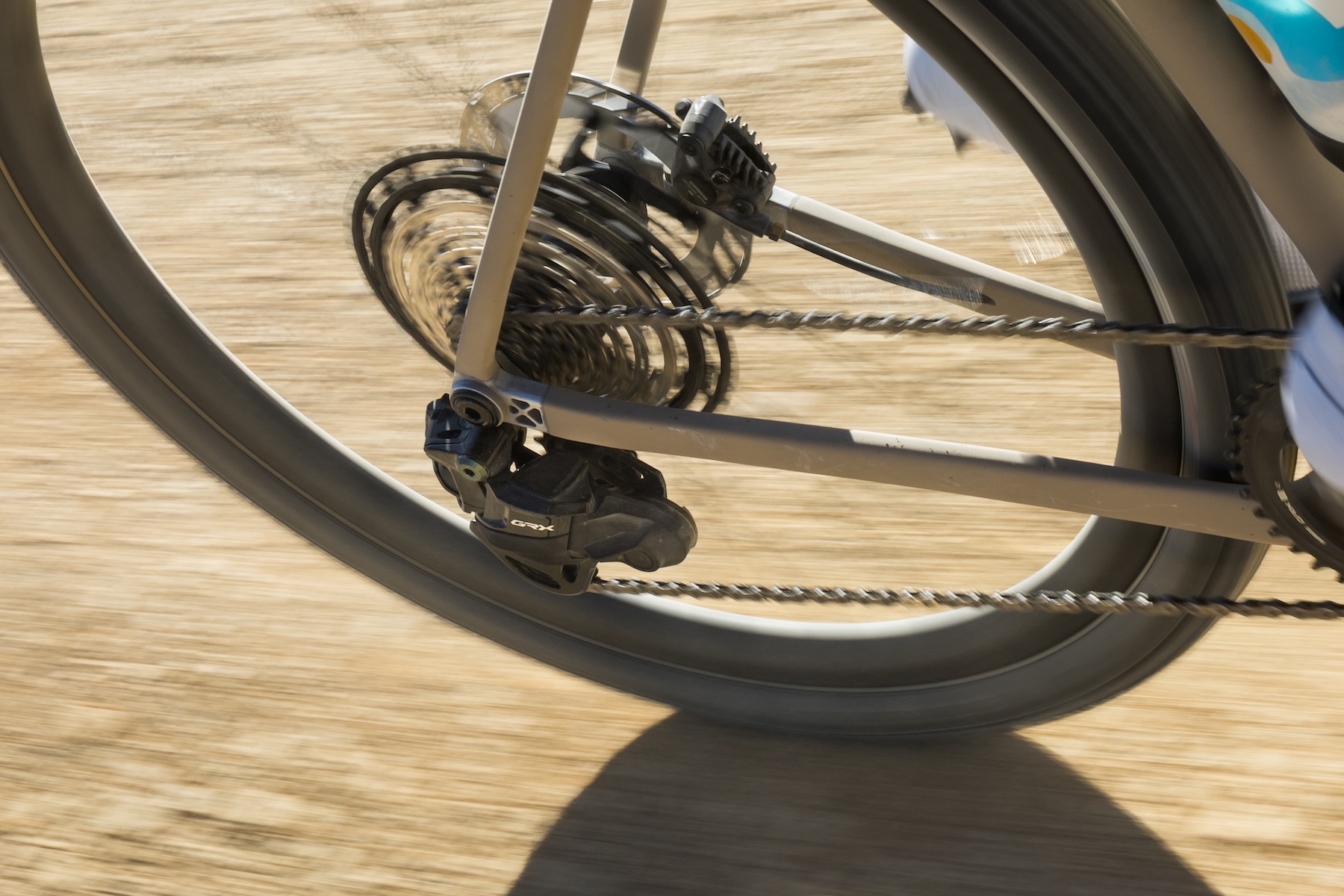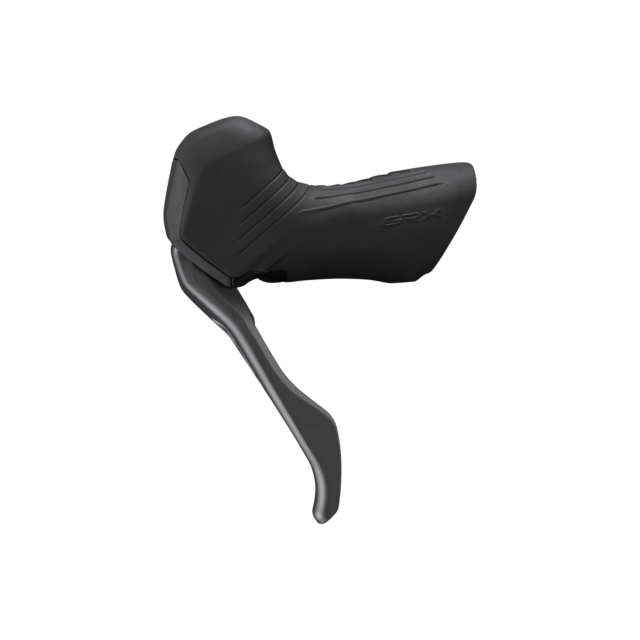EXT Vecta
Stated Weights:
- RX827 rear derailleur: 449 g
- Battery: 26.5 g
- BL-RX825-L lever: 188 g
- Groupset: 2,988 g (full group including levers, derailleur, RX820 crankset with 40T chainring, XT M8100 chain, XT M8200 cassette, battery, and RX820 brake calipers and CL800 discs)
MSRP:
- RX827 rear derailleur: $565 USD / $769 CAD
- Battery: $55 USD / $76 CAD
- BL-RX825-L lever: $345 USD / $443 CAD
- Groupset: $2,282 USD / $3,034 CAD (full group including levers, derailleur, RX820 crankset with 40T chainring, XT M8100 chain, XT M8200 cassette, battery, and RX820 brake calipers and CL800 discs)

Intro
We tested the 2 x 12 GRX RX825 group from Shimano when it was released last year, and that setup remains on my Gravel bike as the best 2x drivetrain I’ve tested. That drivetrain is semi-wireless, relying on a central battery that is wired up to the front and rear derailleurs, allowing the shifters to remain blissfully wire-free (aside from the brake hoses, of course).
A common question was whether Shimano was also working on a 1 x 12 Di2 setup. Well, the release of the new GRX RX827 rear derailleur answers that question. Hot on the heels of the fully wireless XTR and Deore / XT MTB drivetrain releases, the GRX RX827 keeps the same RX825 levers from the 2 x 12 speed group, but moves to a fully wireless 1 x 12-specific rear derailleur.
Let’s walk through the details below.
Design
Unlike the recent XTR and XT releases on the mountain bike side, which included completely new drivetrains and brakes, Shimano’s new 1 x 12 setup for Gravel is based around the existing RX820 cranks and brake calipers and the BL-RX825-R rear brake and shift lever from their 2 x 12 setup. Those parts get paired with a new rear derailleur and the new XT M8200 cassette to make a wide-range 1 x 12 Gravel setup. Sharing is caring, and it’s nice to see cross-compatibility of all of these parts rather than creating new or duplicative versions. We’ll start with a rundown of the new derailleur as the big change here, and walk through shorter summaries of the parts that come together around it.

GRX RX827 Rear Derailleur
The new RX827 rear derailleur borrows heavily from the new XTR, XT, and Deore designs. For folks that didn’t catch those releases, the big news is that Shimano has moved away from the wired central battery setup historically used for their Di2 drivetrains, and now houses the battery inside the derailleur for a fully wireless arrangement.
Shimano’s design sticks with a traditional derailleur hanger rather than following the direct mount direction that SRAM has used with their Full Mount design from their 12-speed Transmission and 13-speed XPLR derailleurs. David wrote up a nice summary of the new design features on Shimano’s wireless MTB derailleurs, which applies to this RX827 unit too:
Shimano’s take is that a derailleur hanger is still important to protect the derailleur from certain types of damage (e.g., falling straight down onto a rock), and that maintaining the ability for the derailleur to rotate rearward on its mounting bolt is also valuable.
[For reference, SRAM’s T-Type derailleurs can rotate rearward, too, but the mounting interface introduces a lot more friction in that pivot than there is with a normal derailleur hanger mount. That means that a T-Type derailleur doesn’t move as freely and can get stuck back if you hit it on something, requiring you to get off the bike and reset it.]
Shimano has emphasized derailleur durability and has come up with some interesting design details to meet that goal.
The battery (on versions that feature one — more on that below) is nestled in the middle of the parallelogram and is secured with a slide-on hatch. The motor and gearbox are housed at the back of the derailleur, where they’re shielded from impact damage.
The new derailleurs include an automatic recovery feature, whereby it can get pushed inboard (i.e., as if performing a downshift) by an obstacle without overloading and breaking the motor / gearbox. The derailleur then shifts itself back to the selected gear once it’s clear of the obstacle.
Shimano has also substantially slimmed down the P-knuckle (the forward part of the parallelogram where the cage mounts) of the new derailleur, and made it much more wedge-shaped to help it deflect off obstacles more effectively. Doing so required redesigning the friction clutch that manages cage / chain movement on their mechanical derailleurs — to the point that it’s no longer a clutch at all.
Shimano refers to the new system as a “stabilizer,” since it uses a pair of springs rather than a clutch to slow the movement of the cage and keep chain slap in check. Shimano says that the spring-based stabilizer also requires no maintenance and won’t experience any performance degradation as it wears, unlike a friction-clutch-based system. The new design is also claimed to increase chain tension by about 70% (it varies a bit depending on the gear) for improved chain wrap and less chance of skipping, even with a well-worn cassette.
The new derailleurs are also compatible with Shimano’s existing wireless Di2 drop-bar and Cues shifters if you want to mix and match.

Shimano says that the battery life should cover between 700 and 1,000 km (435 to 621 miles), and they list the weight of the new derailleur at 449 grams for the lone SGS long cage version. That’s 5 grams lighter than the listed weight for the SGS long cage version of the XT M8250 MTB derailleur, but aside from the GRX branding and a different finish, the two look extremely similar. Shimano doesn’t state any mechanical or functional differences between the GRX RX827 derailleur and its XT sibling.
GRX RX825 Levers
As mentioned above, Shimano has stuck with the ST-RX825 lever design for the rear brake and shifting. I covered the levers in much more detail in my Full Review of the GRX RX825 groupset, but the basic features to note beyond the older GRX RX800 mechanical levers are the more pronounced hood texture, altered geometry to interface better with flared drop bars, and, of course, the electronic paddles. There’s also a third Di2 button inside the hood for customizable functions like controlling a computer, etc.

Obviously, the front shifter isn’t needed here, so Shimano has created a lighter and cheaper lever in the BL-RX825-L that forgoes any electronic buttons or shift levers. It otherwise keeps the same lever geometry, hood pattern, and anti-slip levers from the electronically-enabled ST-RX825 rear brake and shift lever. The weight difference is only a claimed 19.5 grams below the weight of the ST-RX825, but the simpler BL-RX825-L lever costs $345 USD / $443 CAD (including the brake caliper assembly and hose ) versus $595 USD / $808 CAD for the ST-RX825 shift and brake lever (again inclusive of the brake caliper assembly and hose).
The one thing missing here for me is any provision for dropper compatibility with the BL-RX825-L lever.
Just like the 2 x 12 speed setup, the levers are paired with Shimano’s RX820 brake calipers, which are intended for use with their CL800 rotors.
Compatibility
The long cage-only RX827 derailleur is designed around Shimano’s 10-51 12-speed cassettes. While Shimano recommends the updated XT M8200 cassette, other 12-speed cassettes in the range should work as well, provided that they’re 10-51 tooth versions. Those cassettes require a Microspline driver on the freehub, and any of Shimano’s 12-speed chains can be used.
Shimano recommends the RX820-1 crankset to go with the rest of the group. Those are available in 170, 172.5, or 175 mm lengths with either a 40 or 42T chainring.

Some Questions / Things We’re Curious About
(1) Does the new RX827 rear derailleur have any differences in its features or function relative to the XT MTB version, or the XTR one that we’ve already spent time on?
(2) How does the shifting action compare to that of the semi-wireless configuration of the RX825 2 x 12 system we’ve already reviewed?
Bottom Line (For Now)
Lots of folks had been wondering when Shimano would be updating its 1 x 12 GRX offering to be wireless, and that time has finally arrived. The 2 x 12 speed version is excellent, and it’s great to see an option in the simpler, lighter 1 x 12 format.
